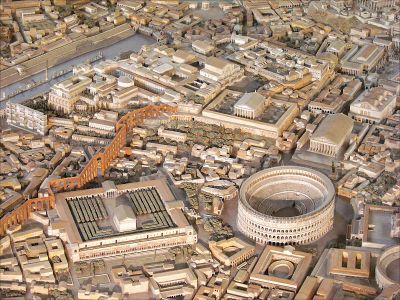Among Italy’s 58 UNESCO World Heritage Sites – the most of any country – the majority include some type of architecture: castles, churches, city centers, dwellings, public spaces, temples, and tombs. Although traces of settlements have been found dating to more than 50,000 years ago, it was during the eighth century BC when the Etruscans began to influence the style of Italian architecture.
In central Italy throughout what are now Tuscany, Umbria and northern Rome, the Etruscans built an empire that in 200 years would extend north – through Emilia-Romagna – to the Po River and south along the coast to Campania. In southern Italy and on the island of Sicily, Greek colonists were establishing cities and building open temples with roofs supported by columns. Trade between the Etruscans and the Greeks brought a blending of Greek architecture and Etruscan design. Many buildings during Etruscan rule were made of wood and have disintegrated; most remaining structures are tombs, with their simple exterior construction revealing lavishly painted interiors. The city of Cerveteri, about 25 miles northwest of Rome, has several temples and numerous tombs that showcase this Etruscan architectural style and highlight the custom of honoring the deceased.
By the third century BC, Roman rule overtook the Etruscan empire. Borrowing from Greek architecture, ancient Roman architecture added arches and domes, and Roman concrete was used for constructing buildings, as well as aqueducts, bridges, reservoirs, and roads.
With the Edit of Milan in 313 AD, the persecution of Christians ended and from the fourth to the sixth century, Early Christian Architecture was the prominent design style as churches and baptisteries were being built. Adding to the foundations of classic Greek and Roman architecture, buildings were constructed with multiple sides, towers and one or more domes. Interiors featured a central nave and side aisles.
In the mid-300s, the ancient Greek town of Byzantium (later known as Constantinople and Istanbul, today) was made the center of the Eastern Roman Empire. As religion became a more important part of life, churches were built to attract new members. Blending Western European with Middle Eastern styles, Italian Byzantine Architecture showcased churches squarer in design with rows of columns and taller domes. Mosaics embellished interiors and high windows allowed more light to filter through.
Constant invasions and battles, financial insecurity, political conflicts, a struggling Roman army and religious differences amongst the rise of Christianity all attributed to the fall of Rome. For almost seven centuries, instability caused economic growth to decline along with new construction. It was during the 11th and 12th centuries with the Norman conquest of southern Italy, the rise of city-states and the Crusades bringing more awareness to Christianity, when new construction began. Borrowing from Roman and Byzantine styles, Italian Romanesque Architecture took hold; churches were more imposing with bell towers, embellished columns, vaulted ceilings, thick walls, and round windows.
In the 1300s, Italian Gothic Architecture developed from Romanesque, with added features of pointed arches, slender columns, crossed arch ribs and flying buttresses. Italian Gothic was somewhat different then Gothic, as villas and churches were designed with regional characteristics. Influenced by the art of the early 14th century, Italian Renaissance Architecture – originating in Florence and influenced by Roman architecture – highlighted harmony through construction using arches and other shapes in symmetry and enhancing the use of columns in the three major orders: Corinthian, Doric and Ionic. Some of the era’s most well-known designers include Leon Battista Alberti, Donato Bramante, Filippo Brunelleschi, Michelangelo and Andrea Palladio.
The 17th century brought a dramatic change with the Italian Baroque Architecture style of curved buildings, intricate carvings, elaborate embellishments, and extravagant facades. One hundred years later, a return to the simpler form of classic Roman and Greek designs was established with Italian Neoclassical Architecture, identified by its straight lines and triangular pediments supported by columns.
At the end of the 19th century, Art Nouveau Architecture, with its freeform style of expression through design, was introduced in Belgium and France. In Italy, it was known as Liberty Style Architecture, and was highlighted at the 1902 Turin Exposition. At the time, Italy was becoming a major tourist destination and many spas and resorts were built in this style.
Between the two world wars, Italy’s government influenced its buildings through Italian Fascist Architecture. Large structures with a simple symmetrical design were constructed, many for the 1942 World’s Fair, which was not held because of the war. After WWII, Italy voted to end its monarchy and become a republic and the era of Italian Modern Architecture began. Carlo Scarpa and Renzo Piano are two noted Italian architects of this style.



